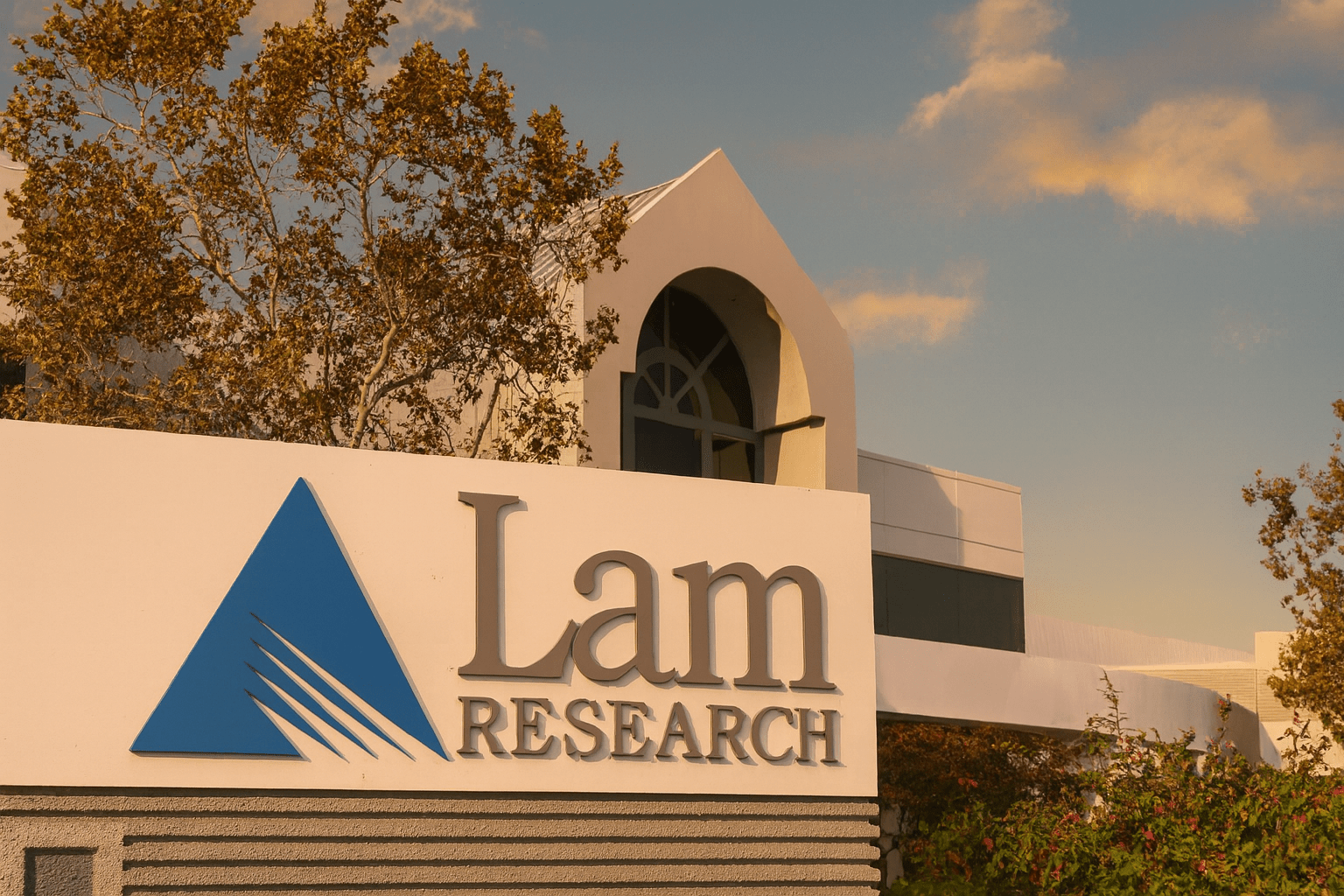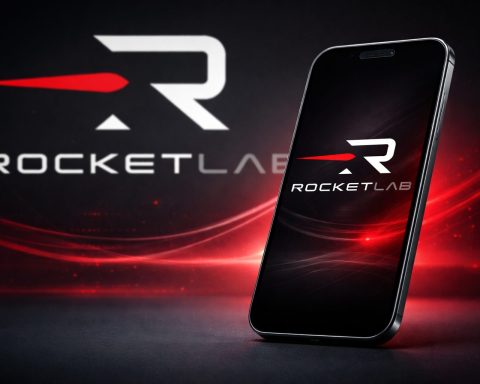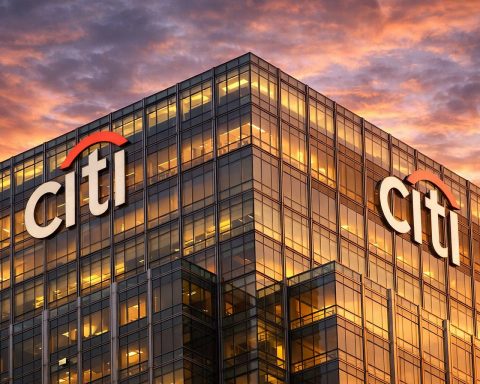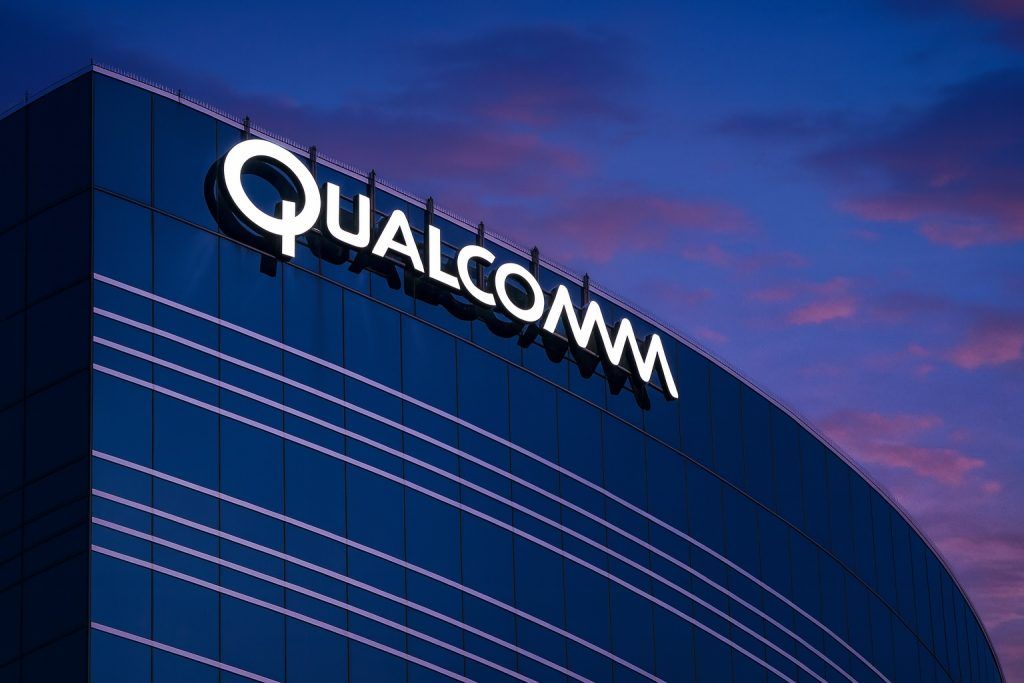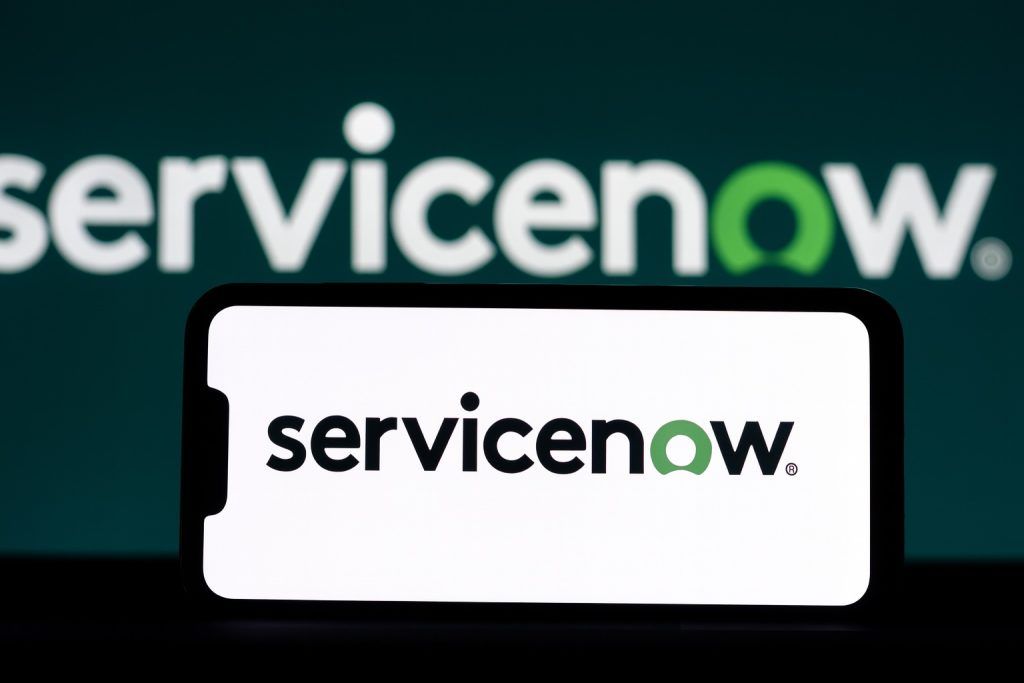What to Know Before Markets Open on October 20, 2025
- LRCX near highs: Lam Research (NASDAQ: LRCX) stock is trading around $141.51 as of Oct. 19, 2025 – up nearly 40% since August and hovering near multi-month highs [1]. Shares have climbed about 19% in the past month, dramatically outperforming both the tech sector (+1.9%) and the S&P 500 (+0.92%) over the same period [2].
- Earnings on deck: Investors are eagerly awaiting Lam’s earnings report on Oct. 22. Analysts project $5.22 billion in revenue (≈+25% year-on-year) and EPS of $1.21 (≈+40% YoY) for the September quarter [3]. Lam’s last results handily beat expectations – Q2 2025 revenue hit $5.17 billion with EPS $1.35, and the company issued upbeat guidance for the current quarter, citing surging demand for AI-related chip equipment [4] [5].
- Positive news flow: Recent developments have been largely positive. Lam hiked its dividend 13% in August (to $0.26 quarterly) amid confidence in cash flows [6]. It also inked a partnership with JSR/Inpria in September to co-develop advanced EUV lithography materials (dry photoresist), aiming to improve chipmaking yields at cutting-edge nodes [7]. In the same month, Lam launched new tools like the VECTOR® TEOS 3D system for chip packaging, targeting the booming 3D integration and chiplet market [8].
- Analysts split on valuation: Wall Street sentiment on LRCX is bullish overall but mixed on near-term upside. The stock carries an average rating between “Buy” and “Strong Buy”, with 22 of 32 analysts rating it buy or better [9]. Notably, Deutsche Bank upgraded Lam to “Buy” on Sept. 29, helping spark a 2% rally that day [10]. However, some are cautious – HSBC initiated coverage at “Hold” with a $127 target, arguing that Lam’s 30% September surge (vs. +13% for the semiconductor index) may have priced in much of the good news [11]. Similarly, Morgan Stanley recently downgraded LRCX on fears that booming demand from China and memory chipmakers could cool after two strong years, while others like Stifel and Cantor remain optimistic, citing Lam’s solid positioning in the AI and memory markets [12].
- Chip sector context: Lam Research’s fortunes are tied to the broader semiconductor cycle, which in 2025 has been supercharged by AI and high-performance computing (HPC) trends. As one of the “big three” chip equipment makers (alongside ASML and Applied Materials), Lam is benefiting from heavy investments in cutting-edge chip fabrication – from 3 nanometer processes to next-gen memory. Analysts expected ~20% growth in wafer-fab equipment spending this year as chipmakers like TSMC, Samsung, and Intel race to advance their technology roadmaps [13]. Lam has been innovating aggressively to meet this demand, introducing solutions like dry photoresist for EUV lithography (to enable finer chip features) and new etch tools for 300+ layer 3D NAND memory [14]. These innovations underscore Lam’s critical role in enabling both leading-edge logic chips and the latest memory devices.
- Macro and rivals: Despite strong tailwinds, the industry isn’t without clouds. Geopolitics and China remain a wild card – export restrictions have curbed sales to Chinese clients, and Applied Materials’ CEO recently warned of “wide-ranging implications” from the volatile U.S.–China policy environment [15]. In August, Applied Materials (the largest semiconductor toolmaker) cut its outlook on weaker Chinese demand, sending its stock down 12% and pulling Lam down ~4% in sympathy [16]. Even ASML – which dominates the lithography segment – cautioned it may see flat revenue in 2026 due to macro uncertainty [17]. For now, though, these concerns are balanced by booming AI-driven orders. Notably, Lam’s Q2 sales jumped 33% YoY, and it raised its 2025 industry outlook to ~$105 billion WFE spend, citing resilient demand (even from China) for advanced chip tools [18] [19].
- Outlook: cautious optimism: Looking ahead, the consensus expects Lam’s full-year 2025 revenue to rise ~9% (to around $20.1 billion) with double-digit earnings growth [20]. Many analysts see continued strength in 2025 as AI, cloud, and automotive chip programs fuel equipment orders. Lam’s CEO Tim Archer has called AI “the biggest fundamental technology revolution of our lifetimes,” predicting that chipmakers will keep investing heavily in new tools to meet AI computing needs [21]. At the same time, investors are aware that the current upcycle could moderate: memory chip prices have begun stabilizing (a positive for Lam’s memory equipment sales), but any pause in big fab expansions – or new U.S. export curbs on China – could temper growth.
- Investor watch list: In the coming months, Lam’s earnings call on Oct. 22 will be a key catalyst, as management’s guidance and commentary on order trends (especially from memory and China) could sway the stock. The annual shareholder meeting on Nov. 4 is another event to watch for strategic updates. Beyond company-specific events, macro factors like interest rate policy and trade regulations will influence all chip stocks. For now, Lam Research sits in a sweet spot: the company is fundamentally strong – it earns high marks on profitability and cash flow metrics (a recent Buffett-style “quality” screen gave LRCX an 86% score for its steady earnings and solid balance sheet) [22] – and it’s riding a wave of demand for the tools that make tomorrow’s chips. The stock’s recent surge reflects that optimism. The question is whether Lam can keep up the momentum into 2026 as the semiconductor cycle evolves. On that front, analysts remain guarded but largely upbeat, with price targets ranging from as low as $80 to as high as $165 (averaging in the low-$130s) [23]. In short, Lam Research has emerged as a star of 2025’s tech rally, powered by the AI chip boom – and all eyes are on its next moves to see if this star will continue to rise or take a breather in the new year.
Lam Research’s Rally Fueled by AI and Earnings Beat
Lam Research’s stock performance in late 2025 has been nothing short of remarkable. As of October 19, LRCX trades around $141.5 per share, a level it hasn’t seen in over a year (adjusted for its 10-for-1 stock split in late 2024) [24]. This price represents a nearly 40% gain since early August, when the stock was hovering near $100. The rally has dramatically outpaced broader indices – in the past month alone, Lam’s share price jumped almost 19%, while the Nasdaq tech sector gained under 2% [25].
What’s driving this surge? A key catalyst was Lam’s strong June-quarter earnings (reported July 30) and its bullish outlook. The company, which supplies semiconductor etching and deposition equipment, announced record revenues of $5.17 billion for Q2 2025 – up 33.6% year-on-year – and non-GAAP EPS of $1.33, topping analyst expectations by about 10% [26] [27]. Perhaps more importantly, Lam raised its full-year industry forecast, predicting wafer-fab equipment spending would hit $105 billion in 2025 (up from a prior $100 billion estimate) amid booming demand for AI chips and associated manufacturing tools [28] [29]. This confidence was echoed in Lam’s forward guidance: for the upcoming quarter (the September quarter), Lam forecast revenue around $5.2 billion – significantly above Wall Street’s ~$4.6 billion estimate – and adjusted EPS of ~$1.20 vs. ~$1.00 consensus [30] [31]. The upbeat guidance, driven by “strong demand for specialized chip-making equipment” used in AI processor production, sent Lam’s stock up over 4% in after-hours trading on the earnings day [32] [33].
Behind these rosy numbers is a clear trend: the AI boom. Semiconductor firms worldwide are racing to build advanced AI accelerators and high-performance computing chips, which require the most cutting-edge manufacturing processes. Lam Research’s tools play a critical role in enabling those processes – from plasma etchers that carve nanometer-scale transistor features to deposition systems that lay down ultra-thin material layers on silicon wafers. As CEO Tim Archer noted earlier this year, “AI is probably the biggest fundamental technology revolution of our lifetimes,” and it’s pushing foundries like TSMC to buy more equipment to keep up with customer needs [34]. In other words, Lam is selling the “picks and shovels” in this AI gold rush.
Notably, Lam’s etch and deposition technology is essential for making the latest chips used in AI servers – such as NVIDIA’s GPUs and advanced CPUs – which are built with new transistor architectures (like gate-all-around transistors) and stacked memory (like HBM high-bandwidth memory and 3D NAND flash). These cutting-edge designs typically mean more manufacturing steps and complexity, benefiting equipment suppliers. For instance, Lam’s tools are used in 3D NAND flash fabrication, where chips now stack over 300 layers of memory cells. Lam has been developing next-gen etch solutions to precisely “drill” these deep stacks, which is a challenging feat that chipmakers rely on heavily [35]. Likewise, in logic chip production, Lam is pioneering new techniques such as dry photoresist for EUV lithography – a novel approach introduced at SEMICON West 2025 that could improve how ultrafine patterns are created on wafers by combining deposition and etch steps [36]. These innovations help chip manufacturers push toward the 2 nm and below technology nodes that AI and smartphone chips will soon require.
All this to say, Lam’s strong earnings and stock rally are a direct reflection of its strategic position in the tech supply chain. The company is hitting on multiple cylinders: financially (beating earnings estimates, expanding margins), technologically (rolling out new solutions for industry “inflections”), and in market share. According to one analysis, Lam’s revenue growth over the last year was an impressive +23.7%, outpacing many peers [37]. That momentum is underpinned by resilient demand even in previously soft segments. For example, after a downturn in 2024, memory chipmakers (like Micron and Samsung) have resumed equipment spending to enable next-gen DRAM and NAND – which benefits Lam. During its investor presentation in February, Lam projected a bright future, targeting $25–28 billion in revenue by 2028 (up from ~$16 billion in 2024) as it capitalizes on secular drivers like AI, cloud data centers, and the rise of electric vehicles (which also depend on advanced chips) [38] [39].
Investors, in turn, have taken notice of these tailwinds. Lam’s stock not only rebounded from the 2022–2023 chip downturn but has now eclipsed its pre-split all-time highs in effective value. Market enthusiasm is also evident in valuation metrics – at $141/share, LRCX trades around 32× forward earnings, which is a premium to its historical average but still at a discount to the broader chip equipment industry’s ~38× [40]. This suggests that despite the run-up, some see Lam as reasonably valued relative to growth prospects. Indeed, Zacks Investment Research recently upgraded Lam to a “Buy” rank, noting upward revisions in earnings estimates and highlighting that Lam’s forward P/E is lower than peers’ on average [41] [42]. In essence, the stock’s surge has been grounded in fundamental strength and optimism about the near future, not just hype.
Latest Developments: Partnerships, Products, and Payouts
Beyond raw numbers, Lam Research has delivered plenty of news in recent weeks that underscores its momentum and strategic focus. A few highlights:
- Dry Resist Partnership: On Sept. 15, 2025, Lam announced a collaboration with JSR Corporation (and its subsidiary Inpria) – a major player in semiconductor materials – to cross-license technology and co-develop new photoresists for extreme ultraviolet (EUV) lithography [43]. This is a big deal in the chip fabrication world. Photoresist chemicals are what allow circuit patterns to be “printed” on wafers using lithography light. Inpria specializes in metal oxide photoresists, which are dry resists well-suited for EUV. By teaming up, Lam and JSR aim to advance these materials and related equipment processes (Lam’s Aether dry resist system was hinted at in the news) to help customers print smaller, more precise features on chips [44]. For investors, this partnership signals Lam’s commitment to staying at the cutting edge of chipmaking materials science – an area traditionally led by chemical companies – and potentially gives Lam a differentiated edge in EUV-era patterning. The news also highlights cooperation between equipment firms and materials firms to tackle upcoming challenges like High-NA EUV lithography (the next-gen tools ASML is developing). In short, Lam is ensuring it has a foot in the door of the EUV ecosystem, which could translate to new revenue streams if dry resist technology sees adoption in leading-edge fabs.
- New Product Launch – Advanced Packaging: On Sept. 9, 2025, Lam introduced the VECTOR® TEOS 3D system, an advanced deposition tool designed to solve challenges in 3D chip packaging and chiplet integration [45]. Chip packaging might sound less glamorous than transistor etching, but it’s increasingly critical: as traditional Moore’s Law scaling slows, the industry is turning to chiplets and 3D stacking (think multiple chips in one package, connected vertically) to keep performance improving. Lam’s new Vector TEOS 3D targets a niche in this space – filling the “gaps” between stacked dies with insulating material (using a TEOS-based oxide deposition) to ensure strong, reliable connections. According to Lam, this tool helps enable new AI chip architectures that use multiple silicon tiles and memory stacks in one unit [46]. By expanding its portfolio into the advanced packaging arena, Lam joins peers like Applied Materials who are also investing in back-end manufacturing solutions. This diversification is important: it means Lam can capture business not only in front-end wafer fabrication but also in the emerging market of heterogeneous integration. The launch shows Lam’s agility in addressing the evolving needs of customers like Intel, AMD, and even OSATs (outsourced chip assemblers) that are building the next generation of AI accelerators via chiplet designs.
- Shareholder Returns – Dividend Boost: In late August, Lam’s board approved a noticeable dividend increase, bumping the quarterly payout by 13% to $0.26 per share [47]. While Lam’s dividend yield remains relatively modest (around 0.7% at current prices), the hike is symbolically important. It marked the eighth consecutive year of dividend growth for Lam and reflects management’s confidence in cash generation. Lam is something of a cash machine – for example, in the June quarter it reported a 46% free cash flow margin, more than double the prior year’s (thanks to rising profits and perhaps some one-time working capital benefits) [48] [49]. Returning cash via dividends (and substantial share buybacks, which Lam also does) indicates that even as the company invests in R&D and capacity, it is generating excess cash to reward shareholders. For investors, a growing dividend adds to Lam’s appeal as a long-term holding, and it distinguishes Lam from some high-flying tech names that pay no dividend. The increase to $0.26 also came shortly after Lam’s stock split made shares more affordable to smaller investors, which some speculate might eventually broaden the shareholder base (e.g. inclusion in Dow indices is sometimes easier for lower-priced stocks).
- Investor Events – Conferences and Annual Meeting: Lam’s management has been actively engaging the investment community. In early September, executives presented at Citi’s Global Technology Conference in New York, emphasizing “strategic growth and innovation” (this came on the heels of an investor day in Feb 2025 where a 2028 financial model was unveiled) [50]. They likely discussed opportunities in AI, the outlook for memory recovery, and Lam’s progress in China despite export controls. Coming up on Nov. 4, Lam will hold its Annual Shareholders Meeting, where investors may learn more about long-term strategy and possibly get updates on backlog and supply chain conditions. These events don’t typically move the stock immediately, but they provide context and can build confidence if the messaging is strong. For instance, at the Feb. analyst day, Lam’s projection of ~$6–7 EPS by 2028 (post-split) and revenue growth >50% from 2024 to 2028 helped frame a robust long-term scenario [51]. Investors will watch if management remains upbeat or starts to hedge expectations looking into 2026.
In summary, Lam’s recent news cycle paints a picture of a company firing on all cylinders: collaborating on breakthrough tech, rolling out new products to meet emerging needs, and sharing the wealth with stockholders. This multifaceted approach – innovation, execution, and shareholder return – helps explain why Lam has been a market darling in 2025. It’s not just riding a cyclical wave; it’s also making moves to sustain growth beyond the current upcycle.
How Lam Fits into the Semiconductor Landscape (vs. ASML, Applied, TSMC)
Lam Research is a dominant player in the niche world of semiconductor capital equipment. To understand its prospects, it helps to see how it fits alongside peers and customers:
Peers/Competitors: Lam’s direct rivals are other equipment makers, mainly Applied Materials (AMAT), Tokyo Electron (TEL), KLA Corp (KLAC) in the U.S., and a few smaller specialists. Each has its domain:
- Applied Materials is the largest by revenue and, like Lam, provides a broad range of fab equipment (deposition, etch, etc.). Applied even does some of everything, including CMP polishing and implant tools. In mid-2025, Applied’s revenue was running higher than Lam’s (it reported ~$7.3 billion in the July quarter) but its growth has been slower. Applied warned of weakness in China (its top market) which sent its shares down sharply in August [52] [53]. That warning also dragged on Lam and KLA stocks, since a Chinese spending pullback impacts all tool vendors [54]. However, JPMorgan analysts noted that for Applied (and by extension Lam), the China dip might be more timing-related than structural [55]. One key difference: Lam’s exposure to memory (NAND & DRAM) is a bit higher, whereas Applied has more logic/foundry exposure. So in 2024 when memory was in a slump, Lam was hit a bit harder; conversely, as memory recovers in late 2025, Lam stands to benefit proportionally more. Valuation-wise, after the summer sell-off, Applied traded around 19× forward earnings, cheaper than Lam’s ~23–32× (depending on which earnings estimates are used) [56]. That indicates investors assign Lam a premium, likely due to its faster growth off the trough and perhaps better margin expansion (Lam’s gross margins just exceeded 50% again, a benchmark Applied has been around as well).
- ASML Holding (Netherlands) is unique – it’s the sole producer of EUV lithography machines, which cost over $150 million each and are required for the latest chip nodes. ASML’s market cap dwarfs Lam’s (ASML is often above $250 billion vs. Lam’s ~$80–90 billion). ASML doesn’t compete with Lam directly (lithography vs. etch/deposition are different steps), but in the eyes of investors they’re part of the same “semi equipment” basket. ASML had a stellar first half of 2025 thanks to orders for its new High-NA EUV tools, but it made headlines by saying 2026 could be flat in terms of growth [57]. Essentially, ASML signaled that its customers (the big chipmakers) might moderate purchases after an AI-driven binge in 2025. This cautious outlook from an industry bellwether has made investors slightly wary that the entire sector, including Lam, could see a plateau in a year’s time. Nonetheless, ASML remains incredibly profitable and is still guiding ~30% revenue growth for 2025 [58]. It’s worth noting that ASML’s dependence on a few big customers (TSMC, Intel, Samsung) is a double-edged sword: if those companies cut spending plans, all equipment names feel it. On the flip side, if new chip plants in the U.S. and Europe proceed (spurred by CHIPS Act incentives), Lam and ASML alike could see upside. Interestingly, as of Oct 15, 2025, ASML’s U.S.-listed shares were near all-time highs (around $980), reflecting that the market is still quite optimistic about its long-term trajectory despite 2026 uncertainties [59].
- Tokyo Electron (TEL) is a major Japanese competitor particularly strong in coaters, etch, and cleaning tools. TEL has less visibility in U.S. markets but competes head-to-head with Lam in etch and with Applied in deposition. TEL’s CEO in mid-2025 expressed confidence about beating Chinese competitors despite China’s push for self-reliance [60]. TEL also is partnering with research institutes (like imec) to develop beyond-2nm technologies [61]. While TEL isn’t often discussed in U.S. stock news, it’s a formidable rival – any share gains by TEL in etch or deposition could pressure Lam. As of 2025, though, Lam seems to be holding its own; reports suggest Lam has regained market share in some etch segments in recent years, partly due to its focus on new tech like atomic-layer processes and that dry resist mentioned earlier [62].
- KLA Corp focuses on inspection/metrology equipment (ensuring chips have no defects), not directly overlapping Lam’s process tools. But all these companies’ fates intertwine with semiconductor capital expenditures (capex). If a chipmaker cuts capex, every supplier from lithography to etch to inspection gets fewer orders. That’s why macro news – like interest rates, end-market chip demand, or export rules – often move all these stocks in tandem. For example, when the U.S. tightened export controls on advanced chip tech to China, Lam, Applied, and KLA stocks all typically dip, reflecting lost sales opportunities (Lam at one point warned it could lose ~$2.5 billion in annual revenue from such curbs [63]). Conversely, when NVIDIA posts blowout results or when a government announces a subsidy for a new fab, equipment stocks collectively jump.
Customers and Industry Role: Lam’s customers are basically all leading chip manufacturers. The big ones include TSMC, Samsung, Intel, Micron, SK Hynix, Texas Instruments, GlobalFoundries, and Chinese players like SMIC (to the extent they can buy U.S. tools).
- TSMC (Taiwan Semiconductor) – the world’s largest contract chipmaker – is a bellwether because it spends more on capex than anyone (often $25–30 billion a year). TSMC has been ramping 3nm production and developing 2nm, which require the latest tools (EUV, advanced etch, etc.). TSMC’s CEO has indicated some 3nm capacity might run slightly underutilized in the very near term due to consumer electronics demand, but overall TSMC is still investing for the future nodes [64] [65]. In fact, TSMC is building fabs in Arizona and Japan that will need equipment (though at slightly older tech nodes). For Lam, TSMC is a crucial client especially for etch tools used in EUV double-patterning and the new gate-all-around transistor formation. TSMC’s view on EUV was that they can extend current tech a bit before fully embracing High-NA EUV [66]. That implies more multi-patterning steps, which actually could increase demand for deposition/etch tools from Lam to complement each EUV exposure. TSMC’s spending plans thus directly feed Lam’s order book. In their October 2025 earnings, TSMC did trim 2025 capex slightly but also struck an optimistic tone about AI chip demand offsetting smartphone softness, which bodes well for continued equipment utilization.
- Memory makers (Micron, Samsung’s memory division, SK Hynix) – They had cut equipment orders sharply in 2024 when memory chip prices crashed. Now, as memory prices have been rebounding (especially for NAND flash, partly thanks to supply discipline and even some expected boost from China stockpiling due to U.S. curbs), these companies are cautiously adding capacity again. Lam, being a leader in NAND etch, benefits when NAND makers move to the next layer count (e.g., going from 232 layers to 300+ layers requires new tooling). Samsung and SK Hynix have also been investing in DRAM EUV lithography, which has knock-on effects for Lam’s deposition/etch steps in DRAM. A big wild card was China’s Yangtze Memory (YMTC) – which was on a path to expand NAND production but got hit by U.S. sanctions. To the extent YMTC’s growth is stunted, non-China memory firms gain market share (which could reduce Lam’s China sales but increase elsewhere). In its July report, Lam actually cited “robust orders from Chinese customers” as a driver for its Q2 beat [67], showing that Chinese fabs (likely logic and older-gen memory) were still buying a lot of Lam tools under the export control thresholds. So memory recovery plus China demand = double positive for Lam in 2025.
- Intel – The American chip giant has been behind TSMC technologically but is trying to catch up (Intel 18A process planned for 2025/26). Intel’s success or failure matters to Lam because Intel is a major buyer of equipment. If Intel’s aggressive roadmap stays on track, it will need plenty of new tools (and indeed Intel has ordered High-NA EUV from ASML and likely advanced etch from Lam). Intel also has U.S. government backing to build new fabs in the coming years. Lam’s CEO in Feb 2025 essentially said customers depend on companies like Lam to stay on their roadmaps [68], implicitly referencing partners like Intel which need equipment advances to regain leadership. So far, Intel has still been investing (its capex is huge, though it’s also building foundry capacity that may or may not get fully loaded). Intel’s demand, combined with foundry and memory, rounds out a strong environment for Lam.
In summary, Lam Research is both a leader and a linchpin in the semiconductor supply chain. It competes fiercely with Applied and TEL for market share, but all three are enjoying a robust upcycle thanks to unprecedented chip demand (particularly from AI). Lam’s differentiation lies in its focus on etching and deposition innovations that solve next-gen challenges, and in the relationships it has built with top chipmakers to co-develop solutions. For instance, Lam’s newly unveiled “Akara” conductor etch system (launched in Feb 2025) extends its 20-year leadership in etch by enabling atomic-level precision for 3D transistor structures [69] [70]. Such products keep Lam at the forefront relative to peers – in fact, some analysts consider Lam a potential “disruptor” in how chips are made next, because it’s introducing things like dry resist that could change workflows [71].
The broader sector backdrop remains constructive yet cautious: global chip sales are expected to hit record highs in 2025, and government policies (U.S., EU, Japan, India) are pumping billions into semiconductor infrastructure which ultimately means more fab equipment orders. However, investors know this industry is cyclical. The last big boom (2017–2018) was followed by a downturn. The current boom, driven by AI and geopolitics, could eventually normalize. That’s why even though Lam, ASML, and others are soaring in 2025, there’s an undercurrent of “enjoy it while it lasts, but be prepared for ups and downs.” As of now, Lam’s management and many analysts believe that unlike some past cycles, the AI-driven demand and new tech transitions (like EUV, chiplets, etc.) have created a more durable investment cycle – one that could have legs into 2026–2027 albeit with some moderation.
For instance, ASML’s CEO expects their business to accelerate again later in the decade as High-NA EUV picks up, and Lam’s CFO projected healthy growth through 2028 at the analyst day [72]. And compared to pre-pandemic times, chip companies themselves are keeping larger capital spending budgets as semis become essential to every industry (auto, IoT, AI, etc.). So while the 2026 pause risk (flagged by ASML) is real, the long-term secular need for more and better chips gives companies like Lam a strong foundation.
What Analysts and Experts Are Saying
The dramatic rise of LRCX hasn’t gone unnoticed by market experts. Analysts’ commentary ranges from exuberant to cautious, reflecting the stock’s strong performance and the balancing act of short-term vs. long-term expectations:
On the bullish side, many emphasize Lam’s role as a key beneficiary of the AI revolution. “Lam Research is a key enabler of AI and HPC growth,” wrote one Seeking Alpha contributor in a recent analysis, pointing to the company’s critical tools for advanced chip production and suggesting there’s “more upside ahead” given the secular demand trend [73]. Similarly, Stifel analysts maintained their Buy rating, noting that improvements in cloud “hyperscaler” spending forecasts (think Amazon, Google ramping data center investments) could boost memory market orders, which would directly favor Lam’s business [74]. Cantor Fitzgerald also reiterated a Buy and even raised its price target to $120 (post-split) from $115, after meetings with Lam’s management gave them confidence in the company’s competitive positioning and execution [75]. These bullish voices often underscore that Lam is not just riding a one-time wave – it has entrenched technology leadership. For instance, experts frequently mention Lam’s strides in EUV-adjacent technology like the dry resist and its solid footing in an expanding services business (servicing installed tools yields steady revenue). The Zacks research team noted in October that analyst earnings estimates for Lam have been revised upward in the short term, a positive sign, and assigned Lam a Zacks Rank #2 (Buy) as a result [76]. They also pointed out Lam’s forward PEG ratio ~1.76 is reasonable given its growth rate, slightly below the industry average [77]. All these factors feed into a narrative that Lam’s stock, while not cheap, is backed by real growth and quality metrics.
On the more cautious side, a few analysts are waving yellow flags mainly about valuation and cycle timing. When HSBC initiated coverage in late September with a Hold rating and a $127 target, the analyst acknowledged Lam is “well positioned” for structural WFE demand and projected a healthy 15.7% EPS CAGR (2025–2030) – yet he expressed concern that the near-term growth might slow relative to the big jump this year, making the stock’s rich valuation harder to expand [78] [79]. In their note, HSBC highlighted that Lam’s revenue was up 23.7% in the past year (a huge clip) but that such outperformance versus overall industry spending could normalize [80] [81]. Moreover, they observed Lam’s share price had rallied over 30% in September alone (compared to ~13% for the Philadelphia Semiconductor Index), suggesting a lot of optimism was already priced in [82]. This sentiment – that Lam’s stock might be “priced to perfection” in the short run – is echoed by Morgan Stanley, which downgraded the stock to Underweight. The MS analyst, Shane Brett, argued that after two years of extraordinary growth in China and memory-related demand, Lam could face a plateau, and he set a cautious ~$125 target (implying a pullback) [83]. Similarly, KeyBanc moved to the sidelines (Sector Weight) simply because Lam had blown past their prior price target amid the rally [84].
It’s important to note, however, that even the cautious voices aren’t bearish on Lam’s fundamentals – they’re mostly wary of the stock’s rapid ascent. No major analyst is saying “sell at all costs”; rather, it’s about whether the upside is fully captured or not. In fact, Wall Street’s average 12-month price target for LRCX is roughly $130–$132 (post-split), which is just slightly below the current trading level [85]. That average includes highs in the mid-$160s and lows around $80 [86], revealing a wide divergence of views on how 2025–26 will play out for Lam. The majority of analysts, as mentioned, still rate it a Buy or Strong Buy – about 22 out of 32 tracked ratings [87] – which indicates a prevailing belief in further upside or at least strong performance relative to peers. Brokerage “Buy” ratios are often high in tech, but Lam’s 62% Strong Buy proportion is notably robust [88].
We also see quantitative and model-based assessments giving Lam kudos. A Validea Warren Buffett-style “Patient Investor” model recently gave LRCX an 86% score, citing its consistent earnings, high return on equity, manageable debt, and aggressive share buybacks as signs of a high-quality, value-friendly stock [89]. This kind of screen basically looks for companies with durable competitive advantages (Moats, in Buffett lingo) and Lam’s fundamentals passed most tests with flying colors – the only knock was a slightly subpar return on total capital, but otherwise it underscored Lam’s long-term profitability. Such endorsements from value frameworks are somewhat rare for semiconductor companies, which are often considered cyclical; Lam scoring well suggests it has elements of a compounder stock (steady growth, strong finances) that appeal even to conservative investors.
From the investor commentary side, one theme cropping up is that Lam, along with other semi equipment stocks, could be at an inflection point where they shift from cyclical to “secular growth” stories thanks to AI. For example, a Reuters piece quoted an investment strategist noting that AI-driven demand is creating a more resilient outlook for chip suppliers, as chips are “the new oil” powering the digital economy [90]. That same optimism is tempered by the recognition that things like the Federal Reserve’s rate moves or a potential government shutdown (which was an October concern) can still swing market sentiment in the short run [91] [92].
In summary, expert views on Lam Research converge on a positive long-term narrative – that Lam is a critical player in an essential industry with strong growth drivers – while diverging on how much of that good news is already baked into the stock price after its big 2025 run-up. For now, the bulls seem to have the upper hand given the stock’s strength and the lack of any negative surprise from the company. But all eyes will be on Lam’s October 22 earnings call and outlook commentary. As one might expect, if Lam handily beats the estimates (which, recall, call for ~25% revenue growth YoY [93]) and guides higher again, analysts will likely race to upgrade targets further. Conversely, any hint of order push-outs or a cautious tone about 2026 could give the wary voices vindication and trigger some profit-taking.
Investors are also listening for qualitative clues: order backlog levels, book-to-bill ratios, demand by region (especially China), and how the company is handling supply chain constraints (if any) and gross margin pressures (materials cost inflation, etc.). So far in 2025, Lam’s gross margin ticked above 50%, showing it managed costs well and had a favorable sales mix [94] [95]. Analysts like to see that kind of operational excellence continue.
One more point from analysts: relative performance to peers. In late Q3, Deutsche Bank, as mentioned, upgraded Lam to Buy precisely because they saw it as undervalued relative to its growth and peers. They saw Lam’s pullback in the summer as an opportunity, and indeed from the upgrade point (~$120s) to now ~$141, that call was well-timed [96]. Their note specifically cited that China volatility was clouding the whole sector’s visibility, but that wasn’t a fundamental problem with Lam itself, more a macro overhang [97]. Now that the stock has rebounded, it will be interesting to see if more analysts follow DB’s lead or if some will say “time to lock in gains”. The average brokerage recommendation as of late September was around 1.7 (between Strong Buy and Buy) [98], which is actually quite bullish. Historically, such a consensus often means analysts see further upside in the year ahead.
Overall, the expert consensus portrays cautious optimism: acknowledging that Lam Research is executing very well and riding a powerful industry trend, but also keeping an eye on cyclical realities. Investors reading these tea leaves are likely comforted that few, if any, professionals think Lam is in a bubble or facing imminent collapse of demand – rather, it’s about how sustainable the current growth and valuation are. With that in mind, many agree that Lam remains one of the top names to own for exposure to the ongoing semiconductor boom, especially the AI and memory revival aspects of it.
The Road Ahead: Catalysts and Risks for Lam Research
With 2025 entering its final quarter, what’s next for Lam Research and its investors? Several upcoming catalysts and factors could influence LRCX stock in the coming weeks and months:
1. Earnings Results (Oct 22, 2025): This is the most immediate event. Lam will report its September-quarter (Q3 2025) earnings after the market close on Oct. 22. As noted, expectations are high – analysts predict ~25% revenue growth and ~40% EPS growth year-over-year [99]. Any significant beat or miss versus these numbers will move the stock. Equally important will be Lam’s guidance for the December quarter (or commentary if they don’t give explicit guidance). Because Lam had guided above consensus last quarter, the bar is higher now. Investors will parse the order trends: is AI-related demand still accelerating? Are memory orders picking up or plateauing? One thing to watch is gross margin – Lam crossed 50% last quarter [100]; sustaining or improving that would signal pricing power and efficient execution. If margins slip unexpectedly (perhaps due to higher costs or customer/product mix), it could raise a caution flag. On the call, management’s tone on 2026 will be key: do they affirm confidence that WFE spending will remain around $100B+ next year, or do they hint at a digestion period? Many analysts think Q4 2025 and Q1 2026 could still be strong for equipment makers, with any slowdown more likely in mid-2026, so Lam’s view will be influential.
2. Annual Meeting & Investor Communications: The Nov. 4 Annual Shareholders Meeting might not produce breaking news, but occasionally companies use that forum to discuss long-term strategy or announce shareholder-friendly moves. Given Lam just did a dividend hike, another is unlikely so soon. But investors might listen for any commentary on capital allocation (e.g., will Lam continue aggressive stock buybacks at these price levels?). Also, any update on the search (if any) for new markets or M&A could be interesting – for example, some speculate that equipment firms might eye acquisitions in areas like automation software or components to broaden their portfolio. Lam could also use the meeting to boast about its achievements in 2025, possibly giving qualitative outlook for 2026 (“cautiously optimistic” or the like). Around that time, we might also get sell-side research post-earnings; banks often update their models after results, which could lead to target price changes that impact the stock.
3. Broad Semiconductor News – TSMC, Samsung, etc.: The fortunes of Lam can swing with news from its big customers. For instance, if TSMC announces a major revision to its capex plan (up or down), equipment stocks often react. TSMC’s next big update will likely be in January 2026 when they give a full-year outlook. Similarly, Samsung and Intel provide capex guidance early in the year. Any signals that these companies are cutting back (perhaps if demand weakens or projects delay) would be a negative for Lam. Conversely, surprise capacity expansions or government-funded fab projects would be a plus. One near-term item: the APEC trade summit in November 2025 – it’s been reported that NVIDIA’s CEO and other tech leaders will attend [101], possibly a venue where U.S.-China tech issues are discussed. If trade tensions ease or there’s an agreement that benefits tech exports, Lam could rally on that news. On the other hand, if the U.S. announces new export restrictions (a possibility as they periodically tighten rules on chip tools to China), Lam’s stock could see knee-jerk selling. In 2023 and 2024, such announcements caused volatility; by 2025, a lot of it was known, but one can’t rule out further tightening.
4. Macro Factors – Interest Rates and Economy: While Lam is more influenced by industry dynamics, general market conditions matter too. In late 2025, investors have been concerned about inflation and interest rates, which affect high-valuation tech stocks. If inflation data come in hot and the Federal Reserve signals more rate hikes, that can pressure growth stocks like Lam (higher rates reduce the present value of future earnings). Conversely, if economic data or Fed commentary suggests rate cuts in 2026 (there’s some expectation the Fed might ease if inflation is under control), it could provide a tailwind for the whole tech sector. Additionally, issues like the recently averted U.S. government shutdown (which was looming for Oct 1) can cause short-term market jitters [102]. Any major macro shock (recession concerns, geopolitical conflicts beyond trade, etc.) could impact investor appetite for cyclical stocks like those in semiconductors. But if the macro backdrop remains benign – e.g., moderate growth, easing inflation – then the strong fundamental story of the chip sector could shine through unimpeded.
5. Sector Rotation and Technicals: After such a steep climb, Lam’s stock could be sensitive to sector rotation or profit-taking. Some market strategists note that large-cap tech stocks, in general, led the market in 2025, and there could be a rotation into other sectors (like energy or financials) at some point, which might temporarily cool tech momentum. For Lam specifically, technical analysts might point out that the stock is extended above certain moving averages. Should there be a pullback, key support levels could be around $130 (roughly the September average price) or $120 (where it traded before the late-Sept/early-Oct spike). On the upside, if Lam breaks above the recent peak (~$147 intra-day high in mid-October), there isn’t much in terms of historical resistance (since that would be all-time high territory post-split). In that case, psychological levels like $150 might come into play. Long-term investors will likely look past these wiggles, but shorter-term traders will watch such levels especially around earnings.
6. Industry Cycle Indicators: Investors often track indicators like book-to-bill ratios (new orders vs. filled orders) published for the semiconductor equipment industry. As of mid-2025, those ratios had improved from the 2024 lows, indicating expansion. Should they start to dip below 1.0 again, it could be an early warning of slowing demand. Additionally, the semiconductor inventory levels at chip companies are worth watching. In 2024, a lot of chip firms had excess inventory, which curbed new orders. By 2025, inventory was normalizing, which freed up companies to order more equipment. If we see inventory build-ups again (say, if PC or smartphone demand falters), companies might delay some capacity expansions. Analyst commentary on earnings calls of chipmakers (like Micron, AMD, etc.) regarding capacity and inventories can indirectly signal equipment demand trends.
All told, Lam Research enters late 2025 in a position of strength. The company has tailwind from a secular shift (AI, 5G, IoT – all requiring more advanced chips), plus cyclical recovery in areas like memory. Its stock reflects a good deal of optimism, but by most accounts, Lam has earned that optimism with execution and innovation.
Investors considering Lam now should weigh the short-term risks (could 2026 see a spending pause? is a lot of good news already priced in?) against the long-term growth story (the world’s appetite for computation seems only to be increasing, and Lam is fundamental to supplying that need). Many analysts seem to be effectively saying: “Lam’s a great company; just be mindful of timing.” For those with a long horizon, periodic dips in a quality name like Lam often have proven to be buying opportunities – for instance, those who bought during the late-2024 tech slump (when LRCX was under $75 post-split) have nearly doubled their money in a year.
In conclusion, Lam Research Corp. in October 2025 stands as one of the standout winners of the tech sector, bolstered by record earnings, technological breakthroughs, and investor enthusiasm for the AI era. The stock’s surge into Google News headlines – much like this one – reflects how central semiconductor equipment has become in discussions of the future of tech. As we move into 2026, Lam will be watched as a barometer of the health of the chip industry. The coming earnings and any forecasts will set the tone. For now, both the company’s performance and the industry trends suggest a cautiously optimistic outlook: Lam is at the heart of an ongoing chip boom, even if the pace of that boom may moderate. Savvy investors will be monitoring those earnings calls and industry signals closely, but at the end of the day, companies enabling the world’s chipmaking (like Lam) are positioned in the proverbial “picks and shovels” of the digital gold rush – and that’s not a bad place to be for the foreseeable future.
Sources: Recent market data and analyst reports were referenced from Nasdaq/Zacks [103] [104], Reuters news [105] [106], TS2.tech industry analyses [107] [108], and Lam Research’s own announcements [109] [110], among others, to provide a comprehensive and up-to-date view of Lam Research’s stock performance and business outlook as of October 19, 2025.
References
1. www.macrotrends.net, 2. www.nasdaq.com, 3. www.nasdaq.com, 4. www.reuters.com, 5. www.reuters.com, 6. investor.lamresearch.com, 7. investor.lamresearch.com, 8. investor.lamresearch.com, 9. www.nasdaq.com, 10. www.reuters.com, 11. www.investing.com, 12. www.investing.com, 13. ts2.tech, 14. ts2.tech, 15. www.reuters.com, 16. www.reuters.com, 17. www.reuters.com, 18. mlq.ai, 19. mlq.ai, 20. www.nasdaq.com, 21. www.reuters.com, 22. ts2.tech, 23. www.zacks.com, 24. www.macrotrends.net, 25. www.nasdaq.com, 26. mlq.ai, 27. mlq.ai, 28. mlq.ai, 29. mlq.ai, 30. www.reuters.com, 31. www.reuters.com, 32. www.reuters.com, 33. www.reuters.com, 34. www.reuters.com, 35. ts2.tech, 36. ts2.tech, 37. www.investing.com, 38. www.reuters.com, 39. www.reuters.com, 40. www.nasdaq.com, 41. www.nasdaq.com, 42. www.nasdaq.com, 43. investor.lamresearch.com, 44. investor.lamresearch.com, 45. investor.lamresearch.com, 46. investor.lamresearch.com, 47. investor.lamresearch.com, 48. mlq.ai, 49. mlq.ai, 50. www.investing.com, 51. www.reuters.com, 52. www.reuters.com, 53. www.reuters.com, 54. www.reuters.com, 55. www.reuters.com, 56. www.reuters.com, 57. www.reuters.com, 58. ts2.tech, 59. ts2.tech, 60. ts2.tech, 61. ts2.tech, 62. www.investing.com, 63. www.reuters.com, 64. ts2.tech, 65. ts2.tech, 66. ts2.tech, 67. mlq.ai, 68. www.reuters.com, 69. newsroom.lamresearch.com, 70. newsroom.lamresearch.com, 71. finance.yahoo.com, 72. www.reuters.com, 73. seekingalpha.com, 74. www.investing.com, 75. www.investing.com, 76. www.nasdaq.com, 77. www.nasdaq.com, 78. www.investing.com, 79. www.investing.com, 80. www.investing.com, 81. www.investing.com, 82. www.investing.com, 83. www.tipranks.com, 84. www.investing.com, 85. www.zacks.com, 86. www.zacks.com, 87. www.nasdaq.com, 88. www.nasdaq.com, 89. ts2.tech, 90. www.reuters.com, 91. www.reuters.com, 92. www.reuters.com, 93. www.nasdaq.com, 94. mlq.ai, 95. mlq.ai, 96. www.reuters.com, 97. www.reuters.com, 98. www.nasdaq.com, 99. www.nasdaq.com, 100. mlq.ai, 101. www.reuters.com, 102. www.reuters.com, 103. www.nasdaq.com, 104. www.nasdaq.com, 105. www.reuters.com, 106. www.reuters.com, 107. ts2.tech, 108. ts2.tech, 109. investor.lamresearch.com, 110. investor.lamresearch.com
